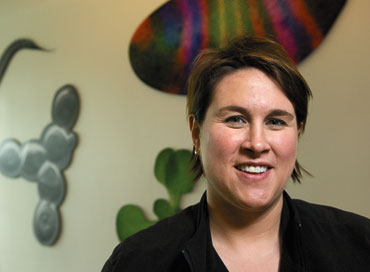With cell as muse, art fuels scientist’s quest
For Ahna Skop, the tipping point to a career in science was a dance and a food fight.

Ahna Skop, assistant professor of genetics, poses in front of oversized images highlighting microscopic science, an art display she coordinated and installed in the lobby of the Genetics–Biotechnology Center.
Photo: Jeff Miller
As a Syracuse University undergraduate, Skop attended her first “worm meeting,” a scientific gathering of researchers who use the soil roundworm Caenorhabditis elegans as their model. Typically, such gatherings are a place for serious science, dense presentations and sober exchanges over biological minutia. To her shock, Skop learned that such gatherings also serve as a social glue of sorts, a way for the people who spend most of their time coping with the ultra competitive pressures of spinning new knowledge to unwind with their peers.
“There was a dance. I learned that scientists actually dance,” Skop says, recalling the meeting that also featured a food fight, a stupefying revelation that scientists are, in fact, human. Like the rest of us, they make fun and, on occasion, the fun can rise to the level of zany — “Animal House” for nerds.
There is nothing in Skop’s deep background that would predetermine a career in cell biology and genetics. The child of artist parents, she grew up in a house “full of nudes and crazy stuff.” She has a degree in ceramics and is not fond of math. She did poorly on tests.
But today Skop finds herself a working scientist, an assistant professor of genetics whose work to unravel the mysteries of cell division is featured in top journals and invited presentations from Beijing to Edinburgh. At the precocious age of 36, she is being given an honorary degree this spring by the College of St. Benedict, recognized as an example of what can be done with a liberal arts degree.
Her scientific inspiration is the cell, or more precisely cell division. Skop’s scientific career gained momentum in 2004 with the publication in Science of a paper describing the proteins in the midbody, the fleeting remnants of the mitotic spindle that briefly connects dividing cells.
Cell division “is probably one of the most simple cellular events there is, but the mechanisms are unknown,” explains Skop. “We don’t know all of the molecules and factors required to pinch off and separate the newly formed cells.”
The act of cell division and its visual nature, Skop admits, is her turn-on: “It’s dramatic. It’s a rapid event. Visually, I’m stimulated by it. I can watch it 1,000 times over. It’s the reason I love what I do. It’s visually impacting.”
Given her preference for soaking up science through visualization, Skop considers herself lucky to have been mentored by John White, a UW–Madison professor of molecular biology and one of the world’s eminent microscopists. “He allowed me to branch out and do what I wanted, and he liked my art stuff.”
She earned her doctorate in White’s lab in 2000 and moved to the University of California, Berkeley, for a postdoc before joining the Wisconsin faculty in 2004.
“I came back here right away because I love this place,” Skop says. “I was weirded out by the San Francisco Bay area. It’s too conservative. The sense of community here is amazing. They want you to succeed here.”
Although Wisconsin, like nearly every research university, has a gender imbalance among its faculty, especially in the sciences, Skop says one of the reasons she was anxious to return to Wisconsin is the number of women faculty.
Her interest in art, too, is encouraged. When hired, she was given the opportunity to transform the lobby of the Genetics/Biotechnology addition into a gallery of art from under the microscope. The opportunity most likely came about because she’d already made a name for herself in the C. elegans world by founding and curating an art show that has become a popular fixture at the annual worm meeting. Entries range from stained glass nematodes to roundworm variants of Warhol.
“It’s funny how the art thing plays to people. It makes things interesting. You don’t have to be like everyone else.”
